Sometimes the best things in life are enjoyable accidents. My long and loving relationship with my wife Lynn started with an accidental meeting, an invitation to attend her high school graduation party, and a kiss that started us on a road that we’re still traveling today. I often wonder if our lives would have turned out differently if we had not had that chance meeting back in 1965.
Serendipity is the word we use to describe the occurrence and development of events by chance in a happy or beneficial way. I experienced it again when I purchased the Weird N.J. book. I went into the store to purchase a magazine, and I found the book by accident as I was walking among the aisles. It, in turn, led me to discover the story of Frankie Lymon’s tombstone.
Serendipity isn’t luck; they’re totally different. Winning the lottery is luck. But actively paying attention to what fate puts in your path and asking deeper questions about how it can be used is serendipity. To benefit from serendipity, one should also have an implicit awareness of the need or opportunity for unsought discoveries and an open mind to how they can fit into your life.
With that in mind, I need to backtrack a bit. The idea for a Michigan Rock and Roll Hall of Fame in Bay City came during a dinner with friends years ago while discussing what Bay City could do with its riverfront. It had once been home to heavy industry, but all that remained, as the 20th century came to an end, were the abandoned, rusting husks of what had once been an important part of the city’s economy. Firms were hired to come up with ideas for future development, and one asked for ideas from the public. 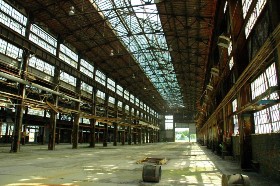 Abandoned industrial building in Bay City
Abandoned industrial building in Bay City
A few years beforehand, I had talked the administration at Cramer Junior High School in Essexville, MI, where I was employed as a classroom teacher, into letting me develop at Rock and Roll history course as an elective offering for 7th and 8th grade students. I attended a week-long seminar at the Rock and Roll Hall of Fame in Cleveland called “So You Want To Be A Rock and Roll Teacher” to get some ideas. While attending the seminar, I discovered there were no textbooks available for junior high students, so I set about to write one for the remainder of the summer.
While researching, I was surprised that there was no rock and hall of fame for Michigan artists. During dinner, I suggested that Bay City would be a good place for a Michigan hall. The following day I wrote a proposal that mentioned Bay City’s central location, as well as some historical facts including it being Madonna’s birthplace and the city where “96 Tears” was recorded. Although my proposal was ultimately rejected, I still thought it had potential.
In 2004, I retired after 35 years in the classroom, and my first post-retirement project was to set up a Michigan hall of fame website. Knowing little about website design, I recruited computer students from Bay-Arenac Skill Center to help me put the early versions of the site together. I called the website Michigan Rock and Roll Legends rather than Michigan Rock and Roll Hall of Fame to avoid being sued by the hall in Cleveland who claimed that they had exclusive rights to the words “Rock and Roll Hall of Fame.” 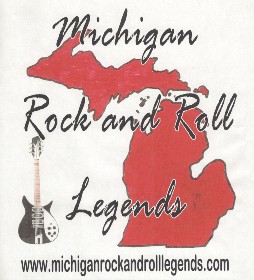 Original MRRL logo
Original MRRL logo
The site eventually included a section that I called Dr. J’s Blog; a place I could write about rock and roll topics that interested me. It was on the blog that I first wrote about Ronnie Italiano and Frankie Lymon’s tombstone. Over the years, I would periodically hear from folks who had been UGHA members or remembered Ronnie and the tombstone in Clifton Music.
As the website gradually attracted more traffic, I began to think about how I might add a physical dimension to the project. Because rock and roll had a strong relationship with automobiles, I formed a partnership with a classic car business called the Bay City Motor Company. Our handshake agreement allowed me to use one of their showrooms to put up photos of the Michigan Hall of Fame inductees as well as other memorabilia. In return, they got a cool looking showroom at no cost. Our partnership worked very well for the next 13 years. 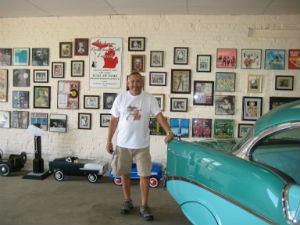 MRRL display at the BC Motor Co.
MRRL display at the BC Motor Co.
While we were visiting our son and his family in New Jersey in July of 2019, I received a call from Scott Cotten, one of the owners of the Bay City Motor Company, saying that their business was moving to a smaller location and that I would have to move my display out of the current location by October.
When we returned to Bay City in early August, my first priority was completing a project to install a historical sign at 405 Raymond Street, the former site of the Art Schiell Recording Studio. The studio had been located in the rear of a residential home, and it was where Question Mark and the Mysterians recorded “96 Tears” in the spring of 1966. I had begun working on the project before we left for New Jersey, and now I had to have the sign made and placed in the front of the dwelling.
I managed to kill two birds with one stone when I spoke with Scott Causley, owner of Scotty’s Sandbar, about installing the MRRL HOF on the walls of his music venue. Besides agreeing to be the new home for the display, he also volunteered to help me put in the “96 Tears” sign.
After the sign was installed, I went over to the Bay City Motor Company to take down my display. There was a sign on the door saying that they were closed for vacation. A week later, I called but there was no answer. I went be the business the next day, but it was still not open. The following week I tried calling and emailing, but I got no response.
The next time I stopped by the business, I was greeted with a sign saying the property was under a court seizure and nothing, including all of my Michigan rock and roll materials, could be removed from the building. I continued to try to contact the owners by both phone and email, but none of my messages were returned. I found out the hard way the pitfalls of a handshake opposed to a written agreement when I called the number for the court officer. I discovered that the lawyer for the Plaintiff in the legal action against the Bay City Motor Company was demanding that that I prove that the Michigan rock and roll memorabilia in the building was mine. 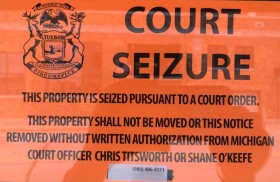 Court seizure sign at B.C. Motors
Court seizure sign at B.C. Motors
I didn’t have receipts for items that I had purchased decades earlier, but I did have a story that I had written on the site that explained my relationship with the Bay City Motor Company. I also had a nice video tour of the display that was produced by my friend Dave Pruden just months before the legal difficulties came to light. I sent both to the lawyer in Troy.
It took over a month, but the story and video were able to convince the Plaintiff’s attorney that all the photos and other memorabilia were my property and not that of the car company. I was notified by phone on the evening of Saturday, September 28, while Lynn and I were attending a reception at the Hell’s Half Mile Film and Music Festival in Bay City. Court officer Shane O’Keefe told me that he would unlock the doors of the Bay City Motor Company at 9:00 A.M. on Monday, September 30. I was told that he would stand guard to make sure that I only removed what was mine and that he charged $65 per hour for his services. 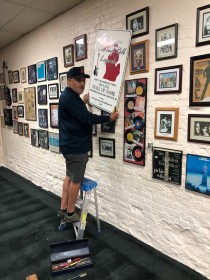 Removal from BC Motor Co.
Removal from BC Motor Co.
I had to write O’Keefe a check for the first hour before we could enter the building on Monday. We were prepared with plenty of boxes, and Lynn and I, along with Scott Causley and Jeff Vande Zande moved everything out in under an hour. I had only met Vande Zande two nights before when Lynn and I shared a table with he and his wife at the reception. I received the call while we were at the table, and when I explained the situation, he kindly volunteered to help out. Yet another example of serendipity.
We stored everything in our garage and left for another visit to New Jersey the following day. In January of 2020, the Michigan Rock and Roll Legends Hall of Fame display was moved into Scotty’s Sandbar and put on the walls with the help of Lynn, Scott Causley, and Bob Charlebois, another talented musician who had been inducted into the MRRL HOF as a member of the band Mad Dog.
A month later, I received a phone call from Mike Bacigalupo, director of the Historical Museum of Bay County, asking me if I was interested in moving the Michigan Rock and Roll Legends Hall of Fame into the museum. I had volunteered to serve on the board of the Bay County Historical Society with the purpose of bringing rock and roll into the museum. My contributions since then had been regular presentations on Michigan’s rock and roll history, with an emphasis on Bay City, for the museum’s Second Saturday series. It was before one of our monthly board meetings that I shared the difficulties I had with the Bay City Motor Company.
Mike Bacigalupo: “I wasn’t aware of the situation at the Bay City Motor Company until Gary told me about it at a museum board meeting. My idea was to put it in a place where the general public can see it. Younger ages can’t go into a bar to see this kind of stuff, but we could bring in classrooms to see these artifacts at the museum. Let’s create a space for the hall of fame so that we can do tours and have a good time with it.”
I liked Mike’s idea because my original concept was for the website to be an educational resource for anyone interested in Michigan’s rock and roll history. The museum would not only make the display more accessible, but it would also serve to further legitimize all the research I had done over the previous 16 years. Mike and I first presented the idea at the February board meeting. The following month, however, the museum was shut down because of the COVID-19 pandemic. Board meetings were suspended, and we began what turned out to be a very grim 12-month period of isolation. 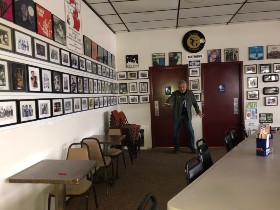 MRRL HOF display at Scotty's Sandbar
MRRL HOF display at Scotty's Sandbar
In the meantime, I decided to keep the display at Scotty’s Sandbar. We had an agreement in place that I did not want to break. Besides, I knew that I could duplicate the hall of fame photos, and I liked the idea that the Michigan Rock and Roll Legends Hall of Fame would have a presence on both the east and west sides of Bay City.
Bacigalupo’s idea was to install the Michigan Rock and Roll Legends Hall of Fame in the DeMara Gallery, located on the museum’s second floor. The most pressing problem was how to fill the gallery with enough interesting memorabilia to attract visitors to the museum?
Google searches on the Internet are perceived as serendipitous due to the abundance of information available for discovery. Fortunately, serendipity entered the picture in the form of an email on August 21st from Nicky Addeo who had found my story about Ronnie Italiano while doing a search on his computer. He wrote an email to thank me for the story and added that he was a singer who had performed at a number of Ronnie’s UGHA doo wop shows.
I had read Bruce Springsteen’s Born to Run memoir the previous year, and I recognized Addeo’s name. He was mentioned in the part of the book where Springsteen was recalling his early days in high school attending teen dances in New Jersey where doo wop was still very popular. Springsteen wrote briefly about Nicky Addeo and how his great falsetto made him the star of the local doo-wop scene.
Addeo was born in Newark in 1943. His mother died young, and after his father remarried, the family moved to Asbury Park. Addeo attended Our Lady of Mt. Carmel for 6th through 8th grade with Danny DeVito. They were both fans of doo wop, and they hung out together until the 9th grade when DeVito’s father sent him to a prep school in a different city. Addeo started singing at the age of 15, and in 1963, as a member of the Darchaes, he recorded a version of the doo wop ballad “Gloria” that became a local hit.  Nicky Addeo and Danny DeVito remained friends over the years
Nicky Addeo and Danny DeVito remained friends over the years
Nicky Addeo: “I met Bruce Springsteen in 1968. I had a band at that time and was playing at a venue called Pandemonium. Bruce knew who I was and came in and asked if he and Vinnie Roslin and Vinny Lopez could sit in with me. From then on, he and I would see each other during the time when Bruce played in the bands Child and Steel Mill. We eventually got a gig alternating the bands, and Bruce let me use his equipment after mine was lost in a fire.”
Addeo’s connection with Ronnie Italiano started in the 70s after he heard Ronnie’s radio show. Nicky called him, and they became friends. As a result, he appeared on several of Ronnie’s shows where he would perform classic doo wop songs like “Gloria” and “My Hero.” Listen to Nicky Addeo perform "Gloria" with members of the E Street Band. https://www.youtube.com/watch?v=XQELbFggZM8
Nicky Addeo: “Ronnie I was an amazing guy. He favored the black groups, and a lot of it was that many of them got screwed during the 50s. Ronnie was a champion of bringing those groups back together, and they loved him. He was a great host and a great friend. Whenever he called on me or I called on him, there was a mutual admiration.”
I always respond when someone sends me an email, and I asked Addeo if he knew what had become of Frankie Lymon’s tombstone? He wrote back that he had lost track after Ronnie’s passing, but that he might be able to put me in touch with someone who might know. At this point, I was looking at using any information I could uncover about the whereabouts of the tombstone to write an afterword to my original story about Ronnie Italiano. The following day, Addeo sent me another email.
Nicky Addeo: “I am forwarding a name to you, Christine Vitale - a long-time associate of Ronnie I. She may be able to help you with your questions. Christine has hosted an R&B radio program for a number of years.”
I wrote an email to Christine on August 24. I asked her if the Clifton Music store was still in operation, and, if not, what happened to Frankie Lymon’s tombstone? Christine replied later that day.
Christine Vitale: “The Clifton Music store is no longer. The building was sold years ago, and it became an optical store. With no place to go, the headstone was given to a lady named Pam Nardella. The Rock & Roll Hall of Fame didn’t want it. No one wanted to pay to transport it. Pam Nardella, who lives not too many miles from Clifton, was able to have it moved to her yard for now - maybe forever. Kind of an anti-climactic ending for something for which so much effort was put forth. I hope this helps you update your story.” Watch Christine Vitale get some things off her chest concerning her Group Harmony Alley radio show. https://www.youtube.com/watch?v=YARvdjHlR1E
If you want to take advantage of serendipity, you have to be open to the possibilities that unexpected discoveries present. As soon as I read Christine’s email, I thought that the tombstone shouldn’t be in someone’s yard – it should be in a museum, maybe the Historical Museum of Bay County.
I immediately wrote back to Christine: “Thanks for your reply. I feel bad that Ronnie's store is gone, but it would have been tough trying to continue to operate an independent music store, especially one that specialized in doo wop. I'm kind of surprised that the Rock and Roll Hall of Fame didn't want the headstone since Frankie Lymon and the Teenagers were inducted in 1993. It was a part of Frankie's life story that was deemed interesting enough to produce a Hollywood movie, and it would have also enabled Ronnie to get a little credit in the HOF for all he did to promote the vocal group genre. I might get back with you if plans go forward to make my Michigan Rock and Roll Legends Hall of Fame part of the Historical Museum of Bay County. If approved, I'll be looking for rock and roll items to display. Even though Frankie Lymon was not a Michigan artist, he was an influence for many Motown artists, and his headstone should be in a museum of some kind.” 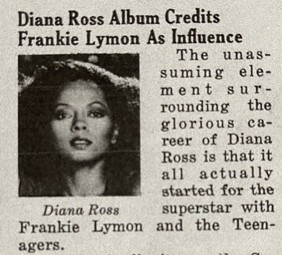 Jet magazine article from 1981
Jet magazine article from 1981
I told Mike Bacigalupo that I thought that the tombstone and the strange story that surrounded it would be the kind of things that would generate a good deal of publicity and attract visitors to the museum. I also said that I was going to try to secure it for the museum on our next trip to New Jersey in mid-October.
Mike Bacigalupo: “I thought the idea of bringing the Frankie Lymon tombstone to the museum was one of the strangest ideas I’ve ever heard, but it was also one of the coolest ideas I’ve ever heard. When Gary brought it up to me, I thought how are we going to make this work and get this done?”
Because of the pandemic, our September 23rd board meeting was held in the Heritage Room, one of the museum’s largest spaces. Everyone was masked and seated at least 15 feet apart. I explained to the board that putting the hall of fame together was going to be a long process, and I told them that I would be investigating the possibility of acquiring Frankie Lymon’s tombstone for the museum during my trip to New Jersey.
It had been over 13 years since I saw the tombstone at Clifton Music. I took a few photos at the time, but I never examined it closely. As a result, I remembered it as not being especially large, and I even thought that I might be able to transport it back to Bay City in our Buick Enclave. I would soon find out that my hazy memory of the tombstone was a far cry from its actual size and weight.
Nicky Addeo sent me Pam Nardella’s email address, and I communicated with her for the first time on October 18th. She was in favor of having the tombstone moved to a museum, but told me that the tombstone was much too heavy for me to transport back to Michigan. I arranged a meeting with her at her home the following week so I could get the tombstone’s exact measurements.
I called Mike Bacigalupo to tell him that we could acquire the tombstone, but it would probably have to be shipped to the museum. He contacted Spencer Skorupski, owner of Skorupski’s Funeral Home in Hampton Township, for advice on how to best get this accomplished. Skorupski said that it was common for tombstones to be shipped across the country, and he volunteered to contact some monument companies in New Jersey on the museum’s behalf and provide us a price range for shipping.
Lynn had been telling me all along that she thought the tombstone was too big for us to bring back to Bay City, but I wasn’t entirely convinced until we took the 30-minute drive from our apartment in Rahway to Elmwood Park on October 25th. Frankie Lymon’s tombstone was in a flower garden filled with the late autumn remains of irises, along with 50’s decorations including pink flamingos and two metal speaker poles usually found in drive-in theaters.
Pam Nardella turned out to be a real sweetheart, the type of person you become friends with after a first meeting. She told us how the tombstone was delivered to her yard, and she had a large number of photos that were taken during its installation. 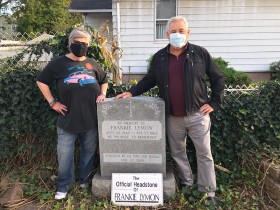 Pam Naradella and Dr. J in her garden
Pam Naradella and Dr. J in her garden
The tombstone was much larger than I remembered. Made of granite, the headstone measured 33 inches high, 27 inches wide, and 8 inches deep, and its granite base brought its weight to well over 1,000 pounds. I emailed the measurements to Spencer Skorupski, who had contacted two New Jersey monument companies on the museum’s behalf, and he had received a rough estimate from one of them of $2,500.
It was both disheartening and sobering to learn a few days later that neither of those companies could do the job because they were too busy as a result of the large number of COVID-related deaths. Since I was in New Jersey, I started calling any other monument companies that I could find on the Internet.
I hit paydirt on my third call when I reached Monroe Monuments, located in Butler, NJ. I spoke with Mike Rullis, and I piqued his interest when I mentioned that the tombstone had historical significance. The fact that its story had been written about in the New York Times, and that there had been a Hollywood movie made about the events surrounding it got him on board with the project.
Rullis, who operated the business with his father Scott, offered $3,000 and I countered with $2,500. To support my offer, I mentioned that I could also provide a good deal of publicity for his business by contacting New Jersey newspapers and television news teams about the museum’s acquisition of the legendary tombstone. That sealed the deal, but he said that they would probably not be able to deliver the tombstone to Bay City until January or February because of the pandemic.
I arranged to meet Mike Rullis at Pam Nardella’s house on November 17th so that he could take a look at the tombstone. I was happy when she told me that the former members of the UGHA were in unanimous support of moving the tombstone to Bay City, but I knew it had to be accomplished soon because the weather was getting colder and the holiday season was approaching.
Once we settled on Friday, December 11th, I contacted Amy Kuperinsky, feature writer for the New Jersey Star-Ledger, about the upcoming tombstone removal. She did phone interviews with me, Pam Nardella, and former Teenager Jimmy Merchant, to put together an excellent article titled “How a Music Legend’s Tombstone Landed in N.J. (and where it's going next).” It covered the backstory of Frankie Lymon’s tombstone and why it was being moved to a museum in Michigan. Read Amu Kuperinsky's story. https://michiganrockandrolllegends.com/index.php/8-general/409-star-ledger-s-frankie-lymon-tombstone-story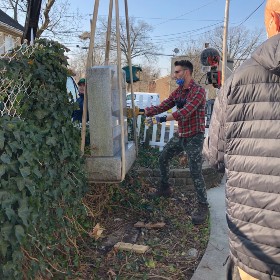 Mike Sullis and his father removing the tombstone
Mike Sullis and his father removing the tombstone
Pam Nardella: “I wanted to be here when the move took place as did some other UGHA members. I sent a message to Jimmy Merchant and Pearl McKinnon, but it was too difficult for them because of COVID-19. I’m really happy that it’s going to a place where it will be loved and cherished. I keep in contact with UGHA members through Facebook, and they are excited to see it have a new home.”
We were lucky to have a bright, sunny day and TV News 12 was on hand for the removal. They produced a nice video segment that was shown on several newscasts that evening. A small group of former UGHA members were on hand to watch Mike and his father use a winch to carefully lift the tombstone onto the back of their truck. Everyone wore masks and respected social distancing during the event. Watch the TV New 12 report on Frankie's tombstone. https://newjersey.news12.com/headstone-of-late-doo-wop-star-frankie-lymon-stood-in-nj-backyard-for-years-now-it-s-headed-to-a-museum?fbclid=IwAR1R3JMghs3cmU2EVwH7FBFfsYhYQQUezXufngZiOND7zLk-GU3VBg-vqxk
Following the removal, Lynn and I spent an hour or so speaking with Pam and Tony Oetjen. As we were leaving, I asked Pam about the two drive-in speakers in her yard. She told me that she had bought five speakers at a Lead East event years before the tombstone was placed in her yard. Pam said that she intended to hook them up to play music in her yard, but she never got around to it. 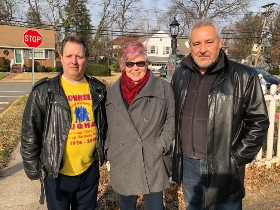 Tony Oetjen, Pam Nardella, and Dr. J
Tony Oetjen, Pam Nardella, and Dr. J
Pam also stated that the other speakers were still in their unopened boxes in her storage shed, and she offered to give me two of them for the museum. Although I had no idea of how I might use them, we packed them into our vehicle. It turned out to be another serendipitous moment.
A Michigan Rock and Roll Legends Hall of Fame exhibit has to include Michigan rock and roll music, and Mike Bacigalupo and I had discussed how that might be accomplished at the museum. We had pretty much decided on putting in a video system in the DeMara Gallery, but we had not come up with a concept. As I was driving back to our Rahway apartment, I thought that maybe we could set up or paint a drive-in movie scene on a wall in the gallery, project the videos on the drive-in screen, and play the music through the speakers that Pam had donated. When we returned to Michigan, I ran the idea past Mike. He loved it, and we started putting the plan into motion.
On January 14, 2021, Frankie Lymon’s tombstone arrived at the Historical Museum of Bay County. A crew from Serenus Johnson had been working on a variety of construction projects at the museum during shutdown, and they brought the crate containing it into the museum’s basement where it would remain for several months. 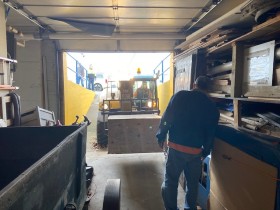 Tombstome crate arrives at the museum
Tombstome crate arrives at the museum
Mike Bacigalupo: “I think the tombstone is going to be a big tell-tale story. When it comes out in the display at the museum, people will relate to the fascinating story behind it. I know the public is going to embrace it, and we are going to get a lot more people into the museum because of the Michigan Rock and Roll Legends Hall of Fame that we’re putting in. The selfish part of me says we’re going to get some people in there that have never been in the museum before, and we’re probably going to prompt some donations from it as well.”
The DeMara Gallery had to be cleared and repainted before the tombstone could be moved into its permanent home. The floor of the gallery also had to be checked to make sure that it could safely hold an object of that weight.
By June 18, 2021, Wendy Zolinski had repainted the walls and floor of the gallery, and the Serenus Johnson crew had moved the tombstone to the second floor via the museum’s elevator. They were now ready to move it into the gallery. It was a tight fit getting it through the doorway. When the tombstone was removed from its crate, it was noticed that the headstone had come loose from its base. The crew separated and cleaned the two pieces of granite before using a powerful adhesive to safely attach them again.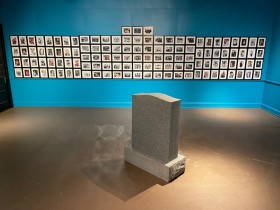 The photo of Frankie's tombstone and the mysterious image
The photo of Frankie's tombstone and the mysterious image
It was placed in the center of the gallery floor, a spot where the joists came together to give its weight added support. The only other items in the DeMara Gallery at this point were the 120 framed photographs of the inductees to the Michigan Rock and Roll Legends Hall of Fame on the wall facing Frankie's tombstone. Some of the inductees, including Bill Haley and Jackie Wilson, shared stages with him during his up and down career. Others, like Berry Gordy Jr., Smokey Robinson and the Miracles, the Supremes, Stevie Wonder, and members of the Temptations, had cited Frankie Lymon and the Teenagers as important influences.
After the crew left, it was very quiet in the gallery. I was the only person on the second floor of the museum, and I took several photos of the tombstone in its new setting. As I was lining up the shots, I thought about all of the events and circumstances that had occurred in the 65 years since "Why Do Fools Fall In Love" had become a hit and how they had all contributed in some way to the tombstone coming to Bay City.
When I got home and looked at the shots I had taken, I noticed an image on the floor to the left of the tombstone. It was probably just a reflection from the lighting in the gallery, but then I let my imagination wander a bit. Maybe that image was the spirit of Frankie Lymon checking out his cool new surroundings and shedding those tombstone blues once and for all.
Afterword
The Michigan Rock and Roll Legends Hall of Fame exhibit officially opened on March 12, 2022, at the Historical Museum of Bay County with the Frankie Lymon tombstone displayed as the centerpiece of the museum’s DeMara Gallery. 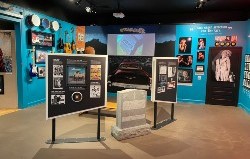
Four display boards were created to tell the tombstone’s story. The first focused on Frankie Lymon’s career with both the Teenagers and as a solo artist. The second stressed the importance of Frankie Lymon and The Teenagers as inspirations for a host of Michigan artists including Diana Ross, whose cover of “Why Do Fools Fall In Love” greatly increased the value of the song’s copyright. The third concentrated on the UGHA’s efforts to place a tombstone on Frankie’s resting place, the famous trial, and the eventual display at Clifton Music. The fourth shows how the tombstone was removed from Pam Nardella’s garden and shipped to the Historical Museum in Bay City, Michigan.
Sources:
Interviews:
Jimmy Merchant, Bill Olb, Pam Nardella, Ron Italiano Jr., Nicky Addeo, Christine Vitale,
Joel Warshaw, Pearl McKinnon, Mike Bacigalupo, and Tony Oetjen.
Books:
Me, The Mob, And The Music by Tommy James with Martin Fitzpatrick.
Born To Run by Bruce Springsteen.
Doo-Wop: The Forgotten Third of Rock ‘n Roll by Dr. Anthony J. Gribin and Dr. Matthew M. Schiff.
Weird N. J.: Your Travel Guide to New Jersey’s Local Legends and Best Kept Secrets by Mark Moran and Mark Sceurman.
They All Sang On The Corner by Philip Groia.
Joel Whitburn’s Top R&B Singles 1942 – 1988.
Joel Whitburn’s Top Pop Singles 1955 – 2002.
The Billboard Book of Top 40 Albums by Joel Whitburn
Articles, Magazines, Websites, Videos etc.
The Best Of The UHGA Vocal Group Video Collection Program Guide by Bill Olb.
Marv Goldberg’s R&B Notebooks – The Teenagers by Marv Goldberg.
Jet magazine– Dec. 3, 1981, Diana Ross Album Credits Frankie Lymon As Influence.
Darby Lloyd Rains – The Rialto Report.
Teenagers: From The Beginning by Dennis Duca, Harmony Tymes (Winter 1987).
Wikipedia: Morris Levy, Frankie Lymon, The Teenagers, Jimmy Merchant, Herman Santiago, George Goldner, Frank Zappa, Sha Na Na, The Beatles, Why Do Fools Fall In Love (movie), Why Do Fools Fall In Love (song), American Graffiti (movie), Alan Freed, Roulette Records, Doo-Wop
Michigan Rock and Roll Legends Website: Amboy Dukes and Doo Wop and Ronnie Italiano: Passion Or Obsession by Gary Johnson
Appalachian Unsolved: Who Killed the Doo Wop DJ? by John North and Leslie Ackerson, Knoxville 10 News, 2018
“Golden Era of Doo Wops: The Groups of Fury Records” CD booklet.
“The Very Best Of Frankie Lymon & The Teenagers” CD booklet
“The Teenagers featuring Frankie Lymon” album cover notes
Three Wives The Legacy of Love by Paula Span, Washington Post, 1988.
Ruling In Lymon Case by Paula Span, Washington Post, 1988.
Legal Widow of 50’s Rock Star Frankie Lymon Dies at AU Medical Center by Don Rhodes, Augusta Chronicle, 2019.
Teen Idol Frankie Lymon’s Tragic Rise and Fall Tells the Truth About 1950s America by Jeff MacGregor, Smithsonian Magazine, 2018.
Alan Freed’s Easter Jubilee souvenir booklet 1956.
Alan Freed Presents The Big Beat souvenir booklet 1958.
Island Hop Television Program: Jimmy Merchant interviews 1 & 2
Life Could Be A Dream: The Doo Wop Sound DVD
Additional photos and memorabilia:
Joel Warshaw, Pam Nardella, Nicky Addeo, and Julia Barrett.
About the Author
Gary (Dr. J) Johnson was born in Bay City, Michigan, in 1946. He was among the first group of children born after World War II who became known as the “baby boomers.” His first exposure to rock and roll was seeing one of Elvis Presley’s early television appearances in 1956. This started him on a hobby that includes a collection of thousands of records, books, tapes, CDs, videos, and DVDs that deal with rock and roll and its history.
Johnson was employed as a teacher in both a parochial and public schools for thirty-five years, and he got his “Dr. J” nickname while coaching numerous championship basketball teams at Cramer Junior High School in Essexville. Over the years, Johnson used rock and roll music in a number of creative ways in his classrooms. In 1996, he wrote the first edition of the Good Rockin’ Tonight textbook and established the first multi-media rock and roll history course at the junior high level in Michigan.
Following his retirement from Cramer Junior High in 2004, he established the Michigan Rock and Roll Legends website and Hall of Fame. That same year, he began teaching Rock and Roll history courses through the Osher Lifelong Learning Institute at Saginaw Valley State University and, in recent years, has taught courses through the OLLI program at Rutgers University in New Jersey.
Since joining the Board of Directors for the Bay County Historical Society, he has been active in presenting both Bay City and Michigan-related rock and roll topics through the Historical Museum of Bay County’s Second Saturday series. As curator, he acquired the legendary Frankie Lymon tombstone from New Jersey as the centerpiece of the museum’s new Michigan Rock and Roll Legends Hall of Fame exhibit.

